Regional Studies
Narratives of Language Landscapes in Qatar: The Language Landscape in Qatar - Workshop I
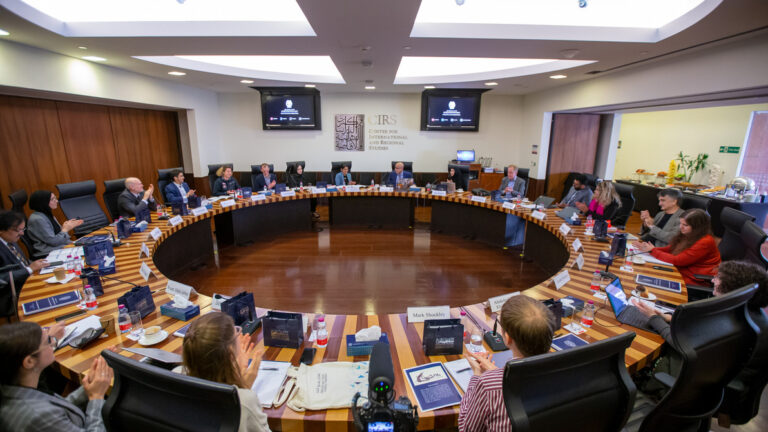
On February 19–20, 2023, the Center for International and Regional Studies (CIRS) hosted a roundtable workshop titled “Language Landscapes of Qatar.” The two-day workshop was the first meeting under the “Narratives of Language Landscapes in Qatar” research initiative led by GU-Q faculty member, Yehia A. Mohamed. The aim of the workshop was to identify understudied areas of research in the field of linguistics of the Arabic language, particularly pertaining to spoken Arabic in Qatar.
The first session was moderated by Dr. Hadeel Al-Khatib, Associate Professor of Educational Sciences at Qatar University. In this session, scholars gave three presentations: “A Non-Najdi Element in Qatari Arabic,” “Historical Linguistic Trends in Gulf Arabic,” and “Mapping the Scholarship on Qatari Arabic and the Language Situation in Qatar.”
Dr. Eiman Mustafawi, Associate Professor of English Literature and Linguistics, and Vice President for Student Affairs at Qatar University, presented one of the features of the Qatari spoken Arabic dialect, noting that it could be considered a trace of a non-Najdi substrate dialect. Qatari Arabic belongs to the group of northeast Arabian dialects, which originated in Najd. However, there is a feature unique to Qatari Arabic—singular demonstrative terms for “this” do not distinguish gender, whereas other northeast Arabian dialects do distinguish between the grammatical masculine and feminine form of “this.” Mustafawi calls this feature gender neutralization of the singular demonstrative in Qatari Arabic. In particular, she has observed that the feminine form of the word is used, regardless of the grammatical gender of the word it refers to. The participants discussed the possible causes of such a dialectical feature, which is the subject of Mustafawi’s research as the initiative moves forward.
Dr. David Wilmsen, a Professor at the American University of Sharjah, presented on the historical linguistic trends in Gulf Arabic. Scholars have “bundled” unique features of Arabic dialects and mapped them geographically in a “broken chain” along the periphery of the Arabian Peninsula. Wilmsen’s presentation focused on the gaps along the “broken chain,” one of them being Qatar as a geographic area, and highlighted where his research may fill those gaps for Qatari Arabic. In the group discussion, the scholars provided examples from their own experiences, noting differences between Arabic speakers in different countries, in proximity to populations speaking another dialect, and also within the same country but of different tribal backgrounds.
In the final presentation of session one, Dr. Yehia Mohamed, Associate Professor of Arabic at GU-Q, and Dr. Muntasir Al Hamad, Associate Professor of Arabic for Non-Arabic Speakers at Qatar University, exhibited their extensive work compiling scholarship on Qatari Arabic. A tremendous feat, the compilation will serve as an incredibly useful tool for any scholar conducting research on Arabic dialects. In the group discussion, scholars traded ideas and suggestions on how the corpus of data could be presented in physical and digital formats for maximum utility.
Session two was moderated by Elizabeth Wanucha, CIRS Operations Manager. In this session, two presentations, “Qatari Arabic Vowel Systems,” and “Sound Changes in Qatari Arabic,” provided an in-depth analysis of sounds unique to Qatari Arabic dialects.
Mark Shockley, a Ph.D. candidate at Leiden University, presented his in-depth work studying Qatari Arabic vowel systems. His study examined if and how Qatari Arabic speakers distinguished between certain vowel sounds appearing in specific contexts. One instance he studied is vowels that are paired with certain Arabic letters pronounced in the back of the throat. In spoken Arabic, this “backness” is reflected in the accompanying vowel. In some Arabic dialects, the consonant determines the vowel to some extent, and certain vowels only occur with certain consonants. If appearing outside of this context, a listener might have issues distinguishing the word. The other instance he studied is the pronunciation of the final vowel in specific contexts. Shockley argues that these vowel sound features seem to be unique to the Qatari dialect of Arabic, which points to further areas of research as this project continues.
The final presentation of the day also examined sound changes in Qatari Arabic. Dr. Vladimir Kulikov, Associate Professor of Linguistics at Qatar University, presented other features unique to Qatari Arabic dialects. His study complements that of Shockley, in that he also looks at the “backness” of vowels. However, he also made an important note of sound differences with the consonants that are pronounced at the back of the throat. In addition to the “backness” of these consonants, they are also characterized by the degree to which the speaker emits a puff of air when pronouncing the consonant sounds. This is called aspiration. Kulikov argues that Qatari Arabic dialects have two unique features related to aspiration and “backness” of these vowels and consonants. For the vowels, Qatari Arabic dialect speakers pronounce the long vowel “a” in a more “back” way than in other dialects. When paired with these “backed” consonants, the vowels are “more backed” than in other contexts. For the “backed” consonants, in most other dialects, “backed” consonants are spoken with very little air emission (aspiration). In the Qatari Arabic dialect, speakers seem to emit more air when pronouncing the “backed” consonants than in other dialects.
Kulikov argues that for Qatari Arabic, the level of aspiration on the consonant in this context is more important than the “backness” of the vowel, which is not the case in other dialects. For example, if a Qatari Arabic speaker hears two similar words, one with a backed vowel and aspirated consonant, and one with a backed vowel and not-so-aspirated consonant, the listener will determine those to be the same word. Whereas in other dialects, those two words would be considered different words due to the difference in aspiration and the difference in the “backness” of the vowel. In the group discussion, scholars debated potential reasons these features developed, and in which population of Qatari Arabic speakers these features are more prominent.
The third session, on day two of the workshop, was moderated by Dr. Christine Schiwietz, Assistant Dean for Curricular and Academic Advising at GU-Q. In this session, presentations covered the topics “Beyond the Question of ‘Arabic or English?’ in Qatar,” “Helping Students Respond to the Linguistic Expectations of Analytical and Argumentative Writing in the Disciplines,” and “The Narrative of Qatari Global Identity as Civic Epistemology: Hospitality, Arts, and Interculturalism.”
Dr. Dudley Reynolds, Senior Associate Dean of Education and Full Teaching Professor of English at Carnegie Mellon University in Qatar, presented on “Beyond the Question of ‘Arabic or English?’ in Qatar.” His presentation centered around two ideas: the way we speak relates to where we come from in society; and, how we look at language is a product of where we come from. Qatar has experienced a range of policies related to use of English and Arabic in schools, public signage, and elsewhere. Reynolds explained how in multilingual societies, such as Qatar, language choice often becomes a competition, with one language “winning.” This can be seen playing out in media, on government websites, in schools, and even on public signs. In the field of linguistics, this environment taken as a whole is known as a “linguistic landscape,” which, in a diverse society such as Qatar, can be quite complex.
The Scaffolding Literacy in Academic and Tertiary Environments Qatar (SLATEQ) project team presented on their work helping undergraduate students meet the writing expectations for their coursework. The team includes three faculty members at Carnegie Mellon University in Qatar (CMU-Q): Dr. Silvia Pessoa, Teaching Professor of English; Dr. Thomas D. Mitchell, Associate Teaching Professor of English; and, Dr. Pia Gomez-Laich, Assistant Teaching Professor of English. With funding from the Qatar National Research Fund (QNRF), the team has spent four years collecting student writing and used the material to adapt the “3×3 Learning Toolkit” (Humphrey et al., 2010) to the fields of study at CMU-Q. The 3×3 model considers a written text’s ideational meanings (representing knowledge), interpersonal meanings (aligning readers), and textual meanings (organizing texts) within the whole text, parts of the text, and sentences/clauses within the text. The team has used this model in writing workshops they offer to students, and they also embed themselves in courses with faculty partners.
The final presentation of this session was given by Dr. Wisam Abdul-Jabbar, Visiting Professor at Hamad bin Khalifa University (HBKU). Abdul-Jabbar’s presentation covered “The Narrative of Qatari Global Identity as Civic Epistemology: Hospitality, Arts, and Interculturalism.” He started by reviewing the state of citizenship education in Qatar at present. In Qatar’s highly multicultural setting, even local Qatari citizenship as an identity has taken on internationalized and globalized facets. Abdul-Jabbar explored this through three components: hospitality, arts, and interculturalism. As the project moves forward, Abdul-Jabbar will examine the following research questions: to what extent and under what conditions does hospitality to foreigners define the responsibilities of Qatari citizens? Is there a Qatari architectural global identity, and what does it tell us about Qatari civics? Which Qatari and Islamic ethics, customs, values, and practices qualify as intercultural?
The final session of the two-day workshop covered “Other Languages in Qatar and their Relationship with Arabic,” and “The Linguistic Landscape of Public Signage in Qatar.” Dr. Irene Theodoropoulou, Associate Professor of Linguistics at Qatar University, moderated the session.
Dr. Andrei Avram, Professor of English Linguistics at the University of Bucharest, Romania, presented on other languages in Qatar, and suggested potential areas of further study. According to Avram, Qatari Arabic and other Arabic dialects only constitute approximately twenty-eight percent of the languages spoken in Qatar. The majority of other languages are Asian, including Bengali, Farsi, Hindi, Indonesian, Malayalam, Nepalese, Urdu, and others. The other non-Arabic, non-Asian languages spoken in Qatar, including English, constitute only twelve percent of the languages spoken in Qatar. Farsi, Urdu, and Hindi have even contributed words to the Gulf Arabic lexicon. Another interesting component of the Qatari language landscape is what is termed Gulf Pidgin Arabic and Arabic Foreigner Talk, which are often spoken among communities that do not share a common language. With the spread of English to Gulf countries, Avram also suggested the areas of Arabic-English code-switching, New Englishes, and Pidgin English as further areas of research.
Dr. Rizwan Ahmad, Associate Professor of Linguistics at Qatar University, and Dr. Sara Hillman, Assistant Professor at Texas A&M University in Qatar, gave the final presentation on the use of language on public signs in Qatar. Following a screening of his 20-minute documentary, Ahmad described the sociolinguistic context within which Qatari dialect spellings were used on street signs. Notably, many street signs in Qatar are written in Arabic script, which mirrors Qatari Arabic dialect pronunciations instead of the expected Standard Arabic ones. Ahmad highlighted how the use of nonstandard Arabic spelling displays a complex interplay of language, script, identity, and migration. The documentary shows how supposedly “incorrect” spellings on street signs serve as visual icons that mark public spaces as Qatari. They showcase Qatari identity and heritage as distinct from other Arabic-speaking societies. Ahmad and Hillman’s presentation complemented that of Dudley Reynolds, and also touched on language policy for public signs. How shopkeepers choose to display Arabic and English on their signs forms an important part of the language landscape for the populations living in that area.
In the wrap-up session, Dr. Yehia Mohamed led a group discussion to explore the next steps for the project. As part of the research initiative, the group aims to compile at least one written publication, with further digital components published online. A second workshop will take place in fall 2023 to study the sociolinguistic narratives in Qatar.
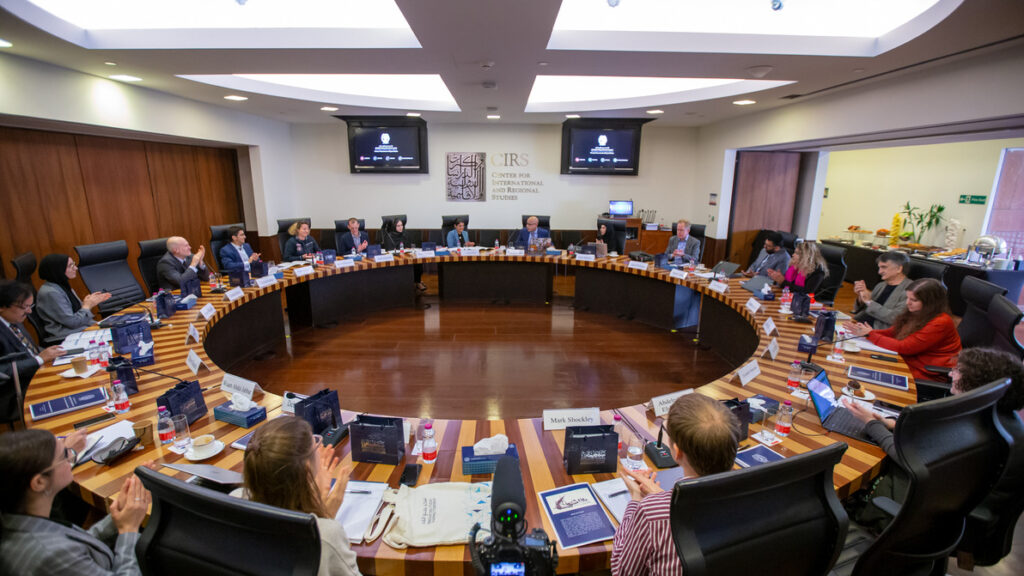
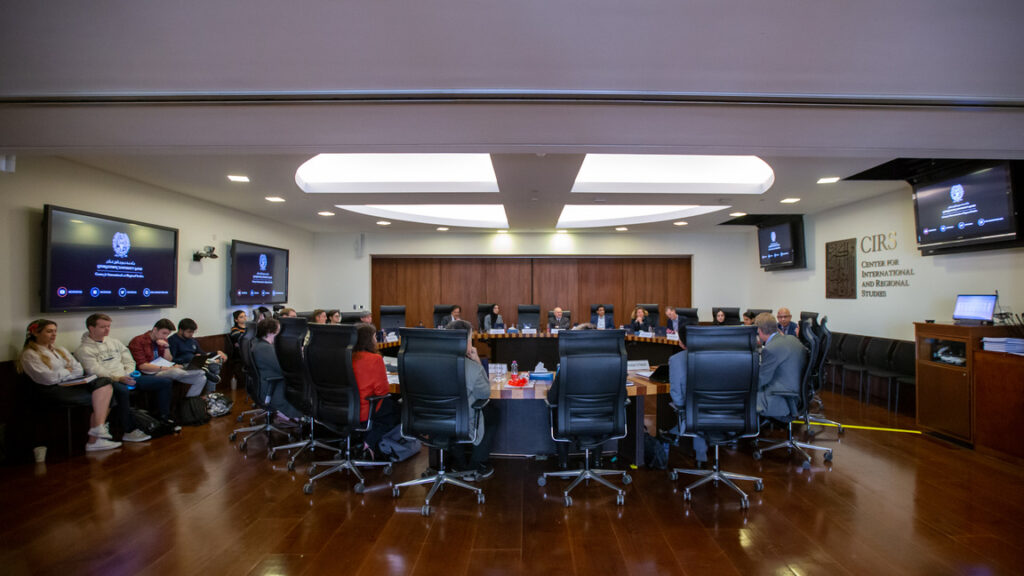
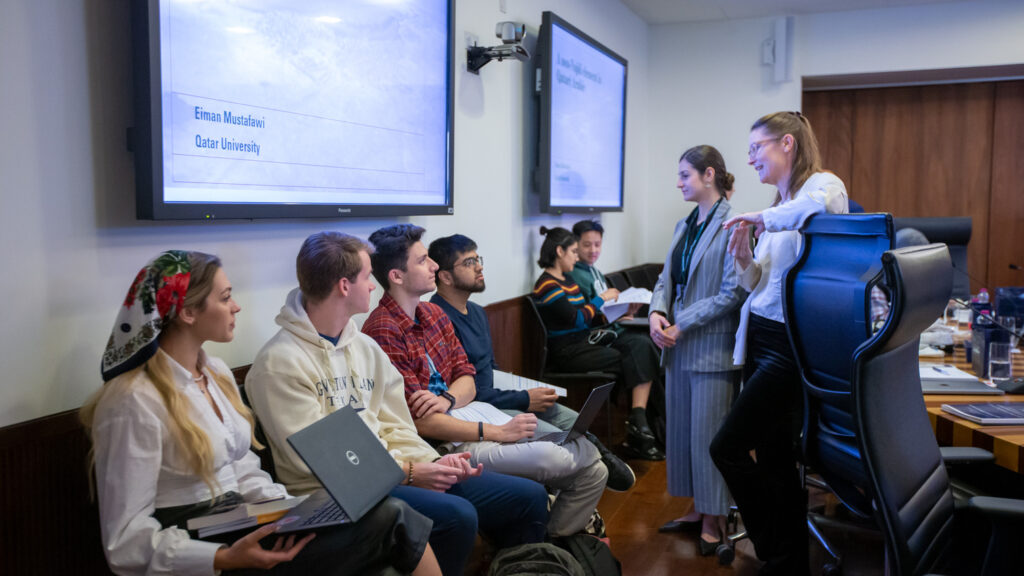
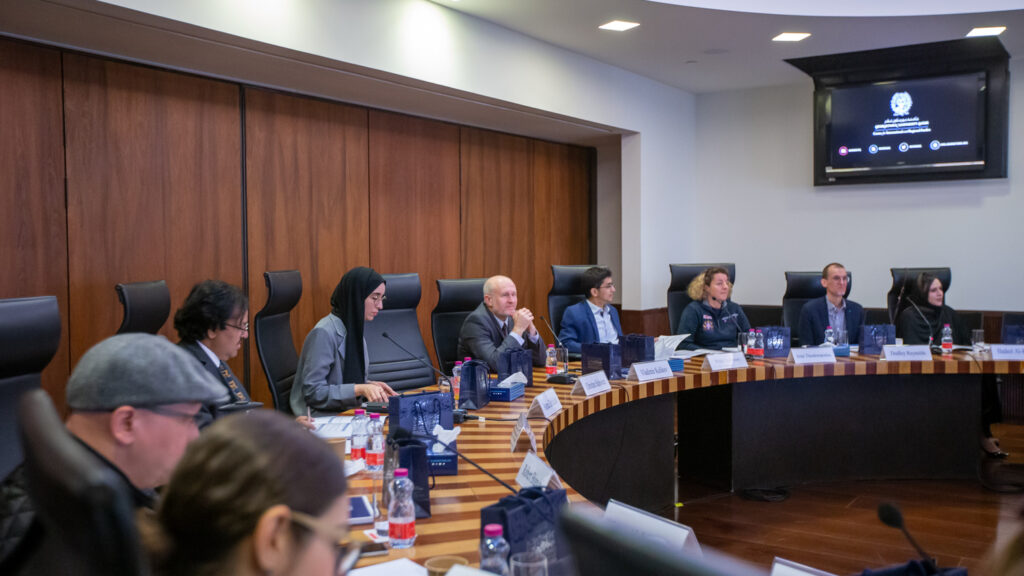
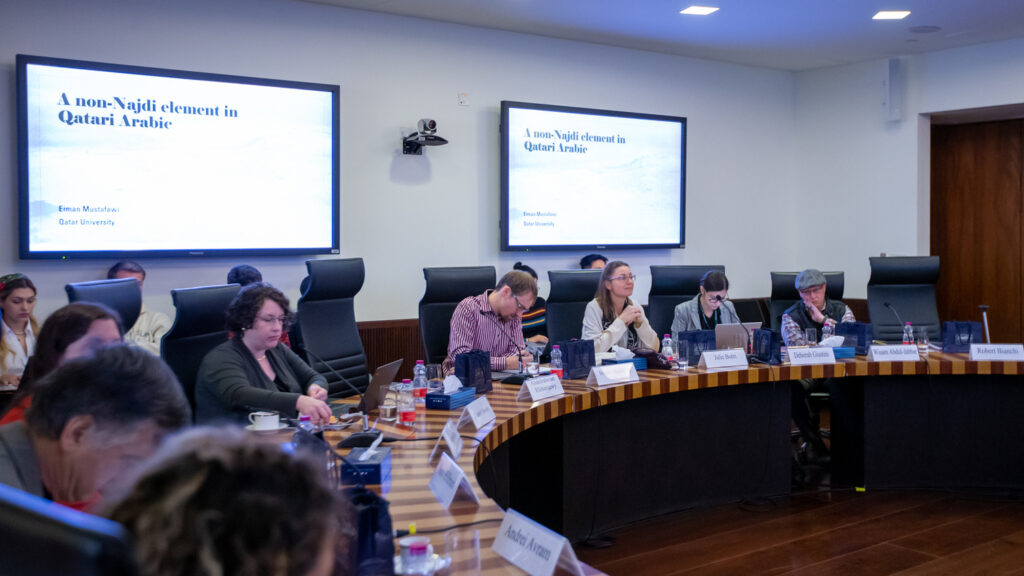
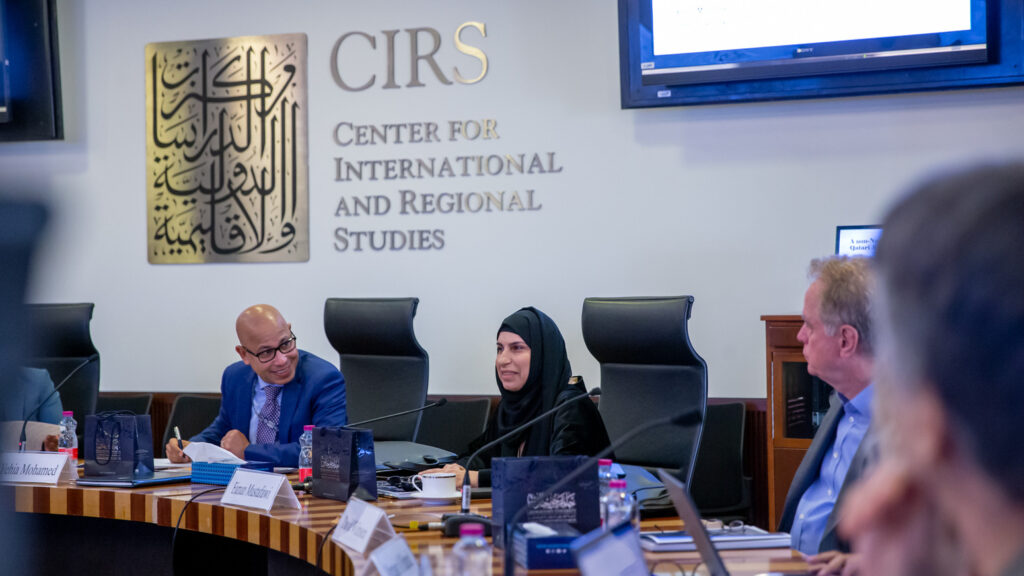
Article by Elizabeth Wanucha, CIRS Operations Manager
- To view the working group agenda, click here
- To read the participants’ biographies, click here
- Read more about this research initiative
Participants and Discussants:
- Wisam Kh. Abdul-Jabbar, Hamad Bin Khalifa University (HBKU).
- Rizwan Ahmad, Qatar University
- Muntasir Fayez Al Hamad, Qatar University
- Hadeel Al-Khatib, Qatar University
- Andrei Avram, University of Bucharest
- Zahra Babar, CIRS – Georgetown University in Qatar
- Robert Bianchi, VCUarts Qatar
- Julie Boéri, Hamad Bin Khalifa University (HBKU).
- Abdelrahman Elsharqawy, Osaka University
- Deborah Giustini, Hamad Bin Khalifa University (HBKU).
- Pia Gomez-Laich, Carnegie Mellon University in Qatar
- Sara Hillman, Texas A&M University at Qatar.
- Vladimir Kulikov, Qatar University
- Suzi Mirgani, CIRS – Georgetown University in Qatar
- Thomas D. Mitchell, Carnegie Mellon University in Qatar
- Yehia A. Mohamed, Georgetown University in Qatar
- Eiman Mustafawi, Qatar University
- Silvia Pessoa, Carnegie Mellon University in Qatar
- Dudley Reynolds, Carnegie Mellon Unive,rsity in Qatar
- Christine Schiwietz, Georgetown University in Qatar
- Mark Shockley, American University of Sharjah
- Irene Theodoropoulou, Qatar University
- Elizabeth Wanucha, CIRS – Georgetown University in Qatar
- David Wilmsen, American University of Sharjah
- Wajdi Zaghouani, Hamad Bin Khalifa University (HBKU).